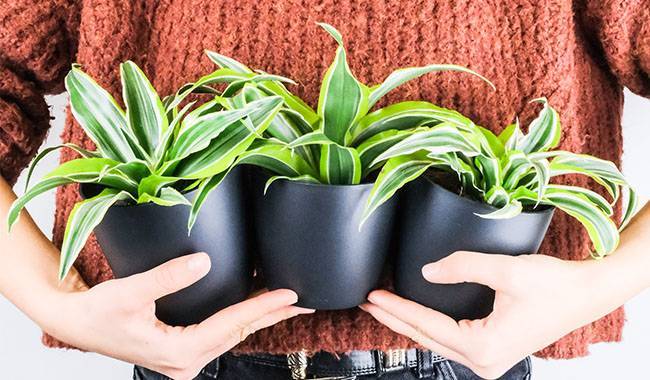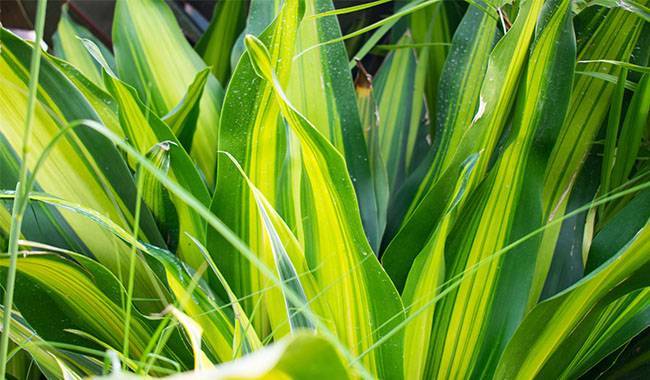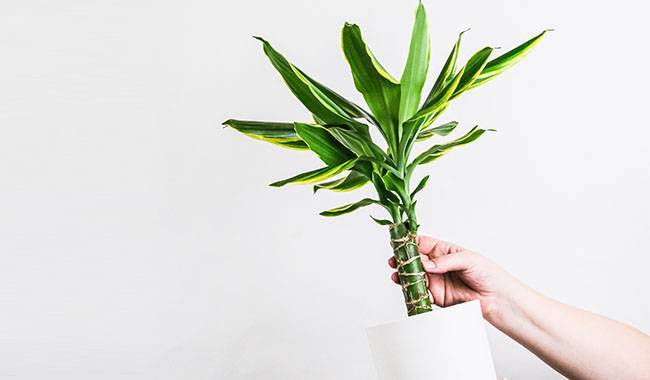
With brightly striped broad leaves that are arranged in rosettes on a perfectly straight, slender trunk, Dracaena’s sometimes called “ti-tree” houseplant is now officially labeled Cordyline australis and looks very striking. It is often compared to the Dracaena plant, but the aromatic beauty of Dracaena deserves a better designation. Bright and eye-catching, its silhouette and color immediately stand out. There are also the Dracaena plant’s, albeit rare, flowers. Despite its popularity, this species cannot be categorized as the most unpretentious Dracaena. The fragrance of Dracaena suffers from even minor mistakes of spillage and sub-optimal lighting. But if you keep the soil and air at a comfortable humidity level, it will show its special beauty. In this article ThumbGarden will learn How to Ficus Microcarpa Care and Grow it.
DRACAENA PLANT DESCRIPTION
The evergreen Dracaena is the most common broadleaf Dracaena species. It can grow in rooms of all sizes, shapes, and uses. Dracaena is so versatile that it can fit into any interior style without overloading the space.
Dracaena is an evergreen shrub with a strong root system, gradually exfoliating straight branches and rosette-shaped, broadly lanceolate leaves found in nature in tropical Africa.
The height of Dracaena depends on its shape. As they age, all Dracaena lose their compactness and stretch out to an uncontrolled height of over 40 inches (1 m). In winter gardens, these false palms can grow to 120-200 inches (3-5 m). The branch on its own only after flowering or after damaging the shoots, but you should not wait in the room for natural separation.
The fragrance of Dracaena can be controlled by creating a “multiple” form on fairly low stems and cutting off the tops of the central shoots.
The leaves of Dracena fragranensis are several times wider than those of ‘Dracaena fragrans’ and marginals – up to 2 inches (5 cm) wide and 15 inches (40 cm) long in the species, and up to 40 inches (1 m) in the basic form – (in nature, the leaves are twice as large). The curved, broadly lance-shaped stiff leaves, with prominent central veins on both sides, are attractive for their glossy, wavy edges and bright colors with broad, irregular stripes. Various shades of grass, light green, and lettuce, white and yellow, are mixed in the variety to create an amazing palette.
Dracaena plant is named for the strong honey scent of its creamy, simple perianth, and the exquisite flowers have numerous beautiful stamens. The sparse, elegant panicles on tall flower stem up to 40 inches (1 meter) are a real surprise and a rare treat in the home.
The fragrant Dracaena is considered one of the best indoor filter plants. It is known for its ability to absorb harmful impurities from the air.
VARIETIES OF DRACAENA

The simple green-leaved Dracaena is very rare. The most common manifestations of this plant in the room are ornamental forms and varieties.
- Striped Dracaena (Dracaena deremensis warneckii ulyses)
We love Dracaena warneckii for its ability to light up empty corners with its long, smooth shape. This Dracaena plant is native to tropical Africa and is named for its beautiful striped leaves. With long, dark green and white striped leaves growing on sturdy stems, the plant’s surprising silhouette adds a touch of whimsy to any interior. - Dragon Tree (Dracaena marginata)
Dracaena marginata is a very popular houseplant. This plant features a tall, thin trunk with long, graceful, red-leaved green shoots. With its tall, slender, slightly abstract silhouette, use Dracaena to add height to an arrangement of houseplants, decorate the space behind a sofa, or catch the eye by adding visual interest to a blank wall. - Cornstalk (Dracaena fragrans)
This multi-stemmed flowering shrub is native to tropical Africa. It is often called Dracaena fragrans because of their resemblance to the crop, it features thick stems covered with long, broad, glossy green leaves. Occasionally, Dracaena fragrans will bloom with small white flowers. - Corn Plant (Dracaena deremensis)
Dracaena deremensis is beloved for its lush, dark green leaves that often resemble the leaves on the actual corn stalk. This plant is native to Africa and can be found in homes around the world. - Song of India (Dracaena reflexa)
Native to Madagascar, Mozambique, Mauritius, and other islands in the Indian Ocean, Dracaena reflexa is often called Song of India. Like a tree, this Dracaena plant has sturdy stems topped by striking evergreen leaves with light and dark green stripes. - Gold Dust (Dracaena surculosa)
Dracaena surculosa is native to African rainforests and has more leaves than stems (compared to other Dracaena plants.) Gold Dust dracaena grows dark green leaves with yellow or white spots that look like they have been sprinkled with gold – hence the plant’s common name 7. - Canary Islands Dragon Tree (Dracaena draco)
Canary Islands Dragon Tree is often referred to by its red sap Dracaena Tree resembles the blood of a dragon. It is native to the Canary Islands and has an unusual profile whether grown in containers or the wild. - Dracaena Tree (Dracaena Arborea)
Dracaena Tree resembles a small palm tree with sword-shaped green leaves and a sclerified trunk. This miniature tree provides warm tropical foliage for any indoor plant landscape. - Mass Cane (Dracaena fragrans massangeana)
Another variety of the Dracaena plant, Dracaena fragrans massangeana (often called mass cane), is characterized by vine stem-like branches that protrude from its trunk and sprout green and yellow striped leaves. Like other Dracaena plants, massangeana is also native to Africa. - Lucky Bamboo (Dracaena sanderiana)
Lucky Bamboo is not bamboo at all. The generic name is really just a clever way to market this unusual Dracaena plant native to Africa. Dracaena sanderiana has bamboo-like stems and sparse foliage that grows in a vase full of water and looks great in displays. - Snake Plant (Dracaena trifasciata)
Dracaena trifasciata is most often referred to as the snake plant and has many common names, including Saint George’s sword, viper’s bowstring, golden bird’s nest, and good luck plant, to name a few. The plant is characterized by its hard, tough, and hardy nature. In addition, this plant is characterized by hard, spiky rosettes of green leaves, sometimes dotted with yellow or light green markings. - Curly or Lucky Bamboo (Dracaena braunii)
Another Dracaena plant masquerading as bamboo is Dracaena braunii. Like Dracaena sanderiana , Dracaena braunii is native to Africa and can grow in water or soil. Its sparse bamboo-like stems characterize it.
GROWING CONDITIONS OF DRACAENA PLANT

The shade tolerance usually attributed to the Dracaena plant is not a characteristic of the mottled form. However, even the most common Dracaena plant can easily be elongated in low light conditions. A considerable distance from a window is not suitable for this species. Bright light will keep the Dracaena plant compact and show off its color on east and west-facing windowsills without direct sunlight (or similar locations).
In winter, the Dracaena plant is recommended to be moved to a brighter location for additional lighting. This species tolerates artificial light well and can grow adequately in a backlit area.
The minimum allowable temperature for Dracaena is about 59 °F (15°C), but the plant may begin to curl and drop leaves in cooler conditions. 60-68 °F (16-20°C) of steady heat is ideal for winter. In summer, Dracaena plants tolerate moderate and high temperatures well, but only with increased air humidity and frequent ventilation.
Dracaena is very fond of fresh air but does not tolerate sharp changes in conditions. In summer, it can be moved to a sheltered place in the garden.
WAYS TO CARE FOR DRACAENA PLANT AT HOME
As a better underwater plant than overwatered, the Dracaena plant is fairly classified as a plant that does not require much care. As long as you remember the basic care procedures and check the soil conditions, it should not cause any problems.
Watering and humidity
A wet, over-watered Dracaena is not forgiven, but ordinary care and draining excess water from the tray is perfectly suited to it. The dryness of the plant’s root ball is easier to tolerate than overwatering, and small delays in watering are not to be feared. Ideally, water the plant only when the upper third of the ground has dried out. Water heavily in summer (no more than twice a week) and less in winter, depending on the temperature.
Watering with hard water is not suitable for this species. It is best to check its temperature, equal to or higher than the room temperature of 35-37 °F (2-3°C).
The greenery of the aromatic Dracaena plant must be kept clean and wiped or cleaned of dust at least once a week.
For the Dracaena plant, humidity should preferably be medium, but it can adapt to a normal room if watered uninterruptedly or in extreme heat. It is best to introduce sprinkling water during the heating season or place a tray with moist pebbles.
Feeding and fertilizer composition
The fertilizer used for the Dracaena plant is selected from a special mixture of ornamental plants and deciduous plants. This species is sensitive to excessive amounts of phosphorus. The standard frequency of fertilization in summer is every 2-3 weeks. In autumn and winter, it can be left out for the first year after transplanting, and from the second year onwards the dosage is reduced and fertilizer is applied every 4-5 weeks.
Pruning and shaping of Scented Leaf Dracaena
To create a multi-trunk form, most varieties need to be pruned to produce new heads. The size of the plant should determine the height of the trunk. Usually, when the trunk is cut to 10-12 inches (25-30 cm), the top should be cut off, leaving 4-5 leaves.
You can also grow several plants in one pot.
Repotting, container, and substrate
This plant is not transplanted but transplanted with the soil block preserved. It is evaluated in the spring, but only when needed – when the rhizomes grow and roots appear in the drainage holes. Dracaena is usually replanted every 2-3 years, replacing only the topsoil in the pot each year.
Choose a loose, nutrient-rich, multi-component substrate for your Dracaena plant. A slightly acidic substrate (pH 5.0 to 6.0) is preferable. A mixture of leafy soil and swampy soil and sand (2:1:1) is suitable for Aromatic Dracaena. Drainage is a must.
Dracaena needs pots that are tall but not too wide. The size should be increased by 1 inch (2.5 cm) each time it is reported. Adult Dracaena often need tubs.
Propagation of Dracaena
Dracaena offspring can be propagated similarly to other Dracaena – by top rooting, rooting from stem cuttings, or aerial picking. Cuttings can be rooted in both soil and water. On average, the first roots do not appear until the 4th to 5th week, so it is best to be patient when propagating this plant.
Pests and problems in cultivation
Pests on Dracaena plants are rare. Spider mites, scales, and mealybugs always indicate care errors and require repeated insecticide treatments.
Dracaena plants only drop leaves in extremely wet conditions or when the substrate is dry for a long time. Usually, minor errors in selection conditions or maintenance are only slightly affected by dry leaf margins and “stalled” growth.







